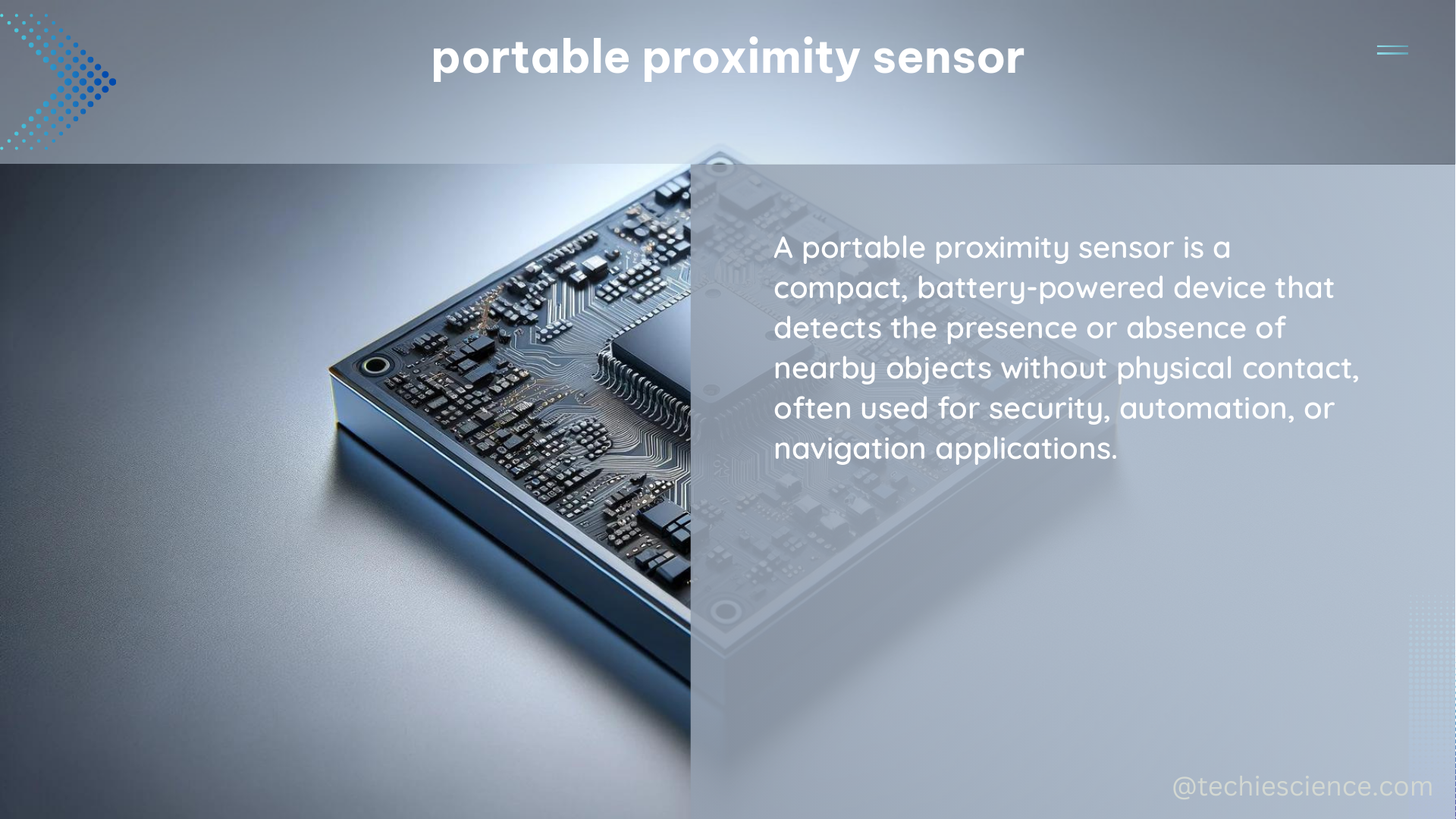Portable proximity sensors are versatile devices that can detect the presence or absence of objects within a specific range without physical contact. These sensors convert physical phenomena, such as electromagnetic fields, ultrasound, or infrared radiation, into measurable signals, making them invaluable in a wide range of applications, including industrial automation, robotics, automotive systems, and security systems.
Understanding the Technical Specifications of Portable Proximity Sensors
The technical specifications of portable proximity sensors can vary depending on the type and manufacturer. However, some common specifications include:
-
Detection Range: The distance at which the sensor can reliably detect the presence or absence of an object. This can range from a few centimeters to several meters, depending on the sensor technology and application.
-
Response Time: The time it takes for the sensor to detect a change in the proximity of an object and generate a corresponding output signal. Response times can range from microseconds to seconds, depending on the sensor type and application requirements.
-
Output Signal: The type of signal the sensor generates, which can be digital (e.g., on/off, high/low) or analog (e.g., 4-20 mA, 0-10 V). The output signal is used to communicate the sensor’s measurements to other devices or control systems.
-
Power Supply: The voltage and current requirements of the sensor, which can range from low-power battery-operated devices to high-power industrial systems.
-
Operating Temperature: The range of temperatures within which the sensor can operate reliably, typically specified in degrees Celsius or Fahrenheit.
-
Environmental Protection: The level of protection the sensor has against environmental factors, such as dust, water, and chemicals, often expressed using IP (Ingress Protection) ratings.
As an example, the Dräger CC-Vision Basic 296, a portable infrared gas detector, has the following technical specifications:
- Detection Range: 0 to 5000 ppm for methane
- Response Time: Less than 60 seconds
- Output Signal: 4-20 mA or 0-10 V
- Power Supply: 24 V DC
- Operating Temperature: -20 to +50°C
- IP Rating: 67 (dust-tight and protected against immersion in water)
Building a DIY Portable Proximity Sensor

Creating a DIY portable proximity sensor can be a rewarding project for hobbyists and makers. The basic components required for a DIY portable proximity sensor include:
-
Microcontroller: A programmable device, such as an Arduino or Raspberry Pi, that can process the sensor data and control the output signal.
-
Sensor Module: The specific sensor component that detects the proximity of objects, such as an inductive, capacitive, ultrasonic, or infrared sensor.
-
Display: An optional component that can be used to display the sensor readings or other information, such as battery level or error messages.
-
Power Source: A battery or USB power supply that provides the necessary power to the sensor and other components.
When building a DIY portable proximity sensor, the sensor module is typically selected based on the desired detection principle and the specific application requirements. The microcontroller can be programmed to process the sensor data and control the output signal, such as lighting an LED or sending a signal to another device.
One example of a DIY portable proximity sensor project is using an Arduino board and an ultrasonic sensor to measure distance. These projects often provide detailed instructions and schematics for building and testing the sensor, as well as suggestions for improving or expanding its functionality.
Advanced Features and Customization
Portable proximity sensors can be further enhanced with advanced features and customization options to meet specific application requirements. Some examples include:
-
Wireless Connectivity: Integrating wireless communication modules, such as Bluetooth or Wi-Fi, to enable remote monitoring and control of the sensor.
-
Data Logging: Incorporating data logging capabilities to record sensor readings over time, which can be useful for analysis and troubleshooting.
-
Sensor Fusion: Combining multiple sensor types, such as proximity, temperature, and humidity, to provide a more comprehensive understanding of the environment.
-
Machine Learning: Integrating machine learning algorithms to enable the sensor to adapt to changing conditions or detect patterns in the sensor data.
-
Enclosure Design: Developing custom enclosures to protect the sensor components and ensure reliable operation in various environmental conditions.
By exploring these advanced features and customization options, DIY enthusiasts can create highly specialized and tailored portable proximity sensors to suit their specific needs.
Conclusion
Portable proximity sensors are versatile and powerful tools that can be used in a wide range of applications. Understanding the technical specifications and building a DIY portable proximity sensor can be a rewarding and educational experience for hobbyists and makers. By leveraging the available resources and exploring advanced features, you can create customized solutions that meet your specific requirements and push the boundaries of what’s possible with these remarkable devices.
References
- Dräger Sensor & Portable Instruments Handbook, 4th Edition, Dräger Safety AG & Co. KGaA, 2018.
- Sensors for daily life: A review, Javaid Mohd Haleem et al., ScienceDirect, 2021.
- What Is A Sensor and What Does it Do?, Dewesoft, 2023.
- How do heat-seeking missiles work? do they work exactly like in the movies?, Explain Like I’m Five, 2021.

The lambdageeks.com Core SME Team is a group of experienced subject matter experts from diverse scientific and technical fields including Physics, Chemistry, Technology,Electronics & Electrical Engineering, Automotive, Mechanical Engineering. Our team collaborates to create high-quality, well-researched articles on a wide range of science and technology topics for the lambdageeks.com website.
All Our Senior SME are having more than 7 Years of experience in the respective fields . They are either Working Industry Professionals or assocaited With different Universities. Refer Our Authors Page to get to know About our Core SMEs.